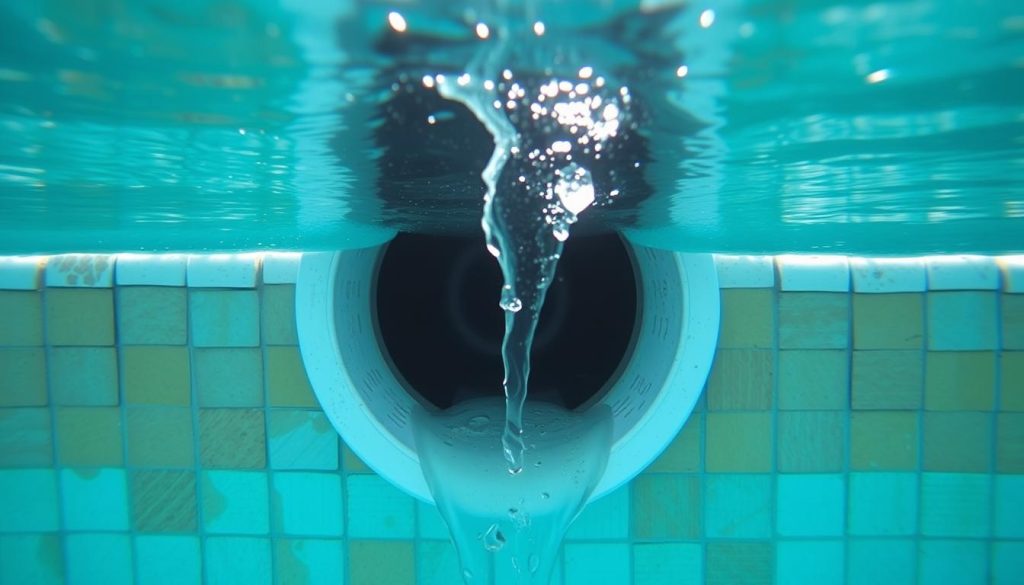
Discovering a pool leak can be frustrating. It’s disheartening to see the water level drop. Leaky pool skimmers often cause water to settle just below the skimmer.
Don’t worry! We’ll help you tackle skimmer line leaks. With some knowledge and effort, you can handle minor repairs yourself. This approach saves money on professional services.
First, confirm the skimmer is the leak source. Use the bucket test to check for leaks or evaporation. If it’s a leak, turn off the fill water.
Watch where the water stops decreasing. If it stops at a crack’s lowest point, the issue is likely the skimmer or pool shell. This method helps pinpoint the leak’s location.
Key Takeaways:
- Skimmer leaks are a common cause of water loss in swimming pools
- Identifying the source of the leak is crucial for effective repairs
- The bucket test can help determine if water loss is due to a leak or evaporation
- Observing where the water level stops decreasing can pinpoint the location of the leak
- Quick fixes for skimmer leaks can save time and money on professional repairs
Identifying Pool Leaks at the Skimmer Level
Pool skimmers are often the source of leaks. This is true when the pump is off and water is higher in the skimmer. Quick identification of skimmer leaks prevents costly damage and repairs.

Common Causes of Skimmer Leaks
Several factors can cause cracks in the skimmer, leading to leaks. These include temperature changes, ground movement, and wear over time.
A loose or worn skimmer gasket can also cause leaks. Regular inspections of these parts help catch issues early.
- Temperature changes
- Ground movement
- Wear and tear over time
Symptoms of a Leaking Skimmer
Recognizing pool leak symptoms is vital for quick repairs. Watch for these signs of a leaking skimmer:
- Water level drops when the pump is off
- Wet spots around the skimmer area
- Sinking deck around the skimmer
If you spot these symptoms, take a closer look at your skimmer. Further investigation may be needed.
Performing a Dye Test to Confirm the Leak
A pool dye test can confirm a skimmer leak. Use a dye needle to squirt small amounts into cracks and around the skimmer.
If the dye is pulled in, it confirms a leak in that area. This test pinpoints the exact leak location, allowing for targeted repairs.
“A pool dye test is a game-changer when it comes to leak confirmation. It’s a simple yet powerful tool that helps us identify the source of the problem quickly and efficiently.” – John Smith, Pool Maintenance Expert
| Leak Location | Dye Test Result | Repair Method |
|---|---|---|
| Skimmer cracks | Dye pulled into cracks | Seal with pool-safe epoxy |
| Skimmer gasket | Dye pulled around gasket | Replace worn-out gasket |
Early detection of pool skimmer leaks is crucial. Regular inspections and prompt action maintain pool integrity. Stay alert and seek professional help when needed.
DIY Solutions for Fixing Skimmer Leaks
Pool owners can often fix leaking skimmers themselves using simple DIY techniques. Quick action prevents further damage and keeps your pool healthy. Let’s look at some effective solutions for skimmer leaks.
Inspecting and Repairing Cracks in the Skimmer
First, check the skimmer for visible cracks. Small cracks can be fixed with pool-safe epoxy. Clean and dry the area before applying epoxy.
Follow the manufacturer’s instructions for best results. For bigger cracks, you might need to replace the entire skimmer.
If damage is severe, ask a pool pro to install a new skimmer. They’ll ensure a proper seal and leak-free operation.
Replacing Worn-Out Skimmer Gaskets
Worn-out or loose skimmer gaskets often cause leaks. The gasket seals the skimmer to the pool wall. Sun, chemicals, and pressure can damage gaskets over time.
Choose the right size gasket and seat it properly for a good seal. Regular checks and timely replacements help prevent future leaks.
According to industry standards, rubber washers, o-rings, and gaskets should be replaced every 1-2 years to prevent drying out and becoming brittle, which can lead to leaks.
Applying Pool-Safe Epoxy to Seal Leaks
Pool-safe epoxy works well for small cracks and leaks. It bonds with pool surfaces to create a watertight seal. Clean and dry the area before applying epoxy.
Mix the epoxy as directed and apply it carefully. Cover the affected area completely. Let the epoxy cure fully before refilling your pool.
| Material | Characteristics |
|---|---|
| PVC (Schedule 40) | Most common for residential pools, thickest and most rigid option |
| CPVC | Better suited for hotter climates due to increased temperature resistance |
| Fiberglass | Used for commercial or high-end pools, offers additional strength at a higher cost |
Knowing pool construction materials helps identify leak sources. It also helps choose the best repair methods for your situation.
When to Call a Professional for Skimmer Repairs
DIY fixes work for minor skimmer leaks. But some issues need a pro pool technician. Call an expert if your repairs fail or you’re unsure how to proceed.
Pros have the know-how and tools to fix tough leaks. They can spot hidden problems and suggest the best solutions.
Professional repairs prevent costly mistakes. They ensure long-lasting results for your skimmer. Experts can find underlying issues like structural damage or worn parts.
Skimmer Injection as a Long-Term Solution
Skimmer injection fixes severe leaks caused by structural damage. It uses expandable foam to fill gaps and cracks. This method stops water from escaping.
A skilled pool tech should perform this task. They’ll assess the damage and use the right amount of foam. The foam expands to create a tight seal.
The benefits of skimmer injection include:
- Long-lasting repair that can prevent leaks for years to come
- Minimally invasive technique that doesn’t require extensive excavation or pool draining
- Cost-effective solution compared to full skimmer replacement
- Improved structural stability for the skimmer and surrounding pool area
Choose a reputable company for your skimmer repairs. Look for certified, insured techs with skimmer injection experience. A good pro will fix your leak efficiently.
Conclusion
Pool leaks near the skimmer can be tricky, but we can handle them with the right know-how. Understanding common causes helps prevent issues. Regular checks and quick fixes keep pools in great shape.
Swift action is key when leaks happen. This keeps water loss low and chemistry balanced. Simple DIY fixes work for minor leaks. For tougher problems, call in the pros.
Stay alert to keep your pool enjoyable for years. Prevent leaks and fix them fast. This saves money on bills and keeps your pool healthy. With the right tools, you can tackle any pool leak.







